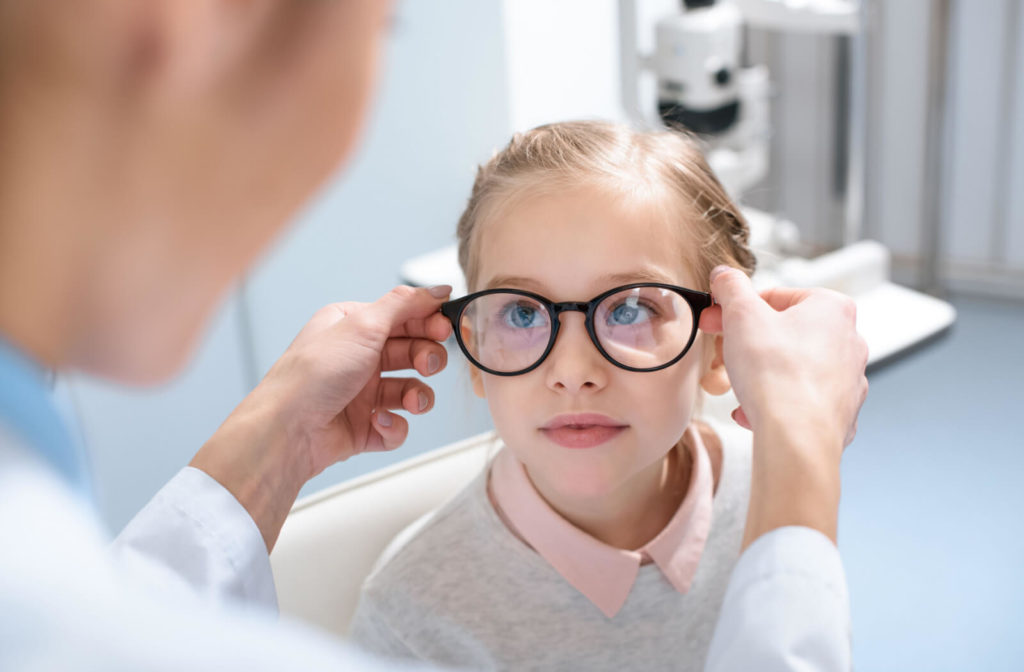“Does my child need glasses?” is a common question that parents may ask themselves when they notice their child squinting or having trouble seeing things. While some children may have obvious vision problems, others may not exhibit any signs at all.
In this blog, we’ll explore the signs and symptoms that may indicate a vision problem and different types of vision problems in children that may require glasses to help you answer this question. We’ll also discuss the importance of regular eye exams.
Reasons Children May Need Glasses
Because children’s eyes continue to develop, glasses can help ensure the normal development of their vision for learning. Glasses may be necessary for children for the following reasons:
- Provide better vision to function in their environment
- Straighten the eyes if they are crossed or misaligned (strabismus)
- Strengthen the vision of a weak eye (amblyopia or lazy eye)
- Protect one eye if the other eye has poor vision
Signs & Symptoms
Determining whether a child needs glasses can be difficult, especially if they are too young to communicate their vision problems effectively. However, there are some signs and symptoms that parents can look out for that may indicate a vision problem. Some of these include:
- Squinting. If your child squints, it temporarily improves the clarity of an object and may be a sign they’re having difficulty focusing on an image.
- Sitting too close to the TV or holding books too close. If your child constantly sits too close to the TV or holds a book or a device too close to their face, it may be a sign that they are nearsighted and struggling to see things at a distance.
- Rubbing their eyes. If your child is rubbing their eyes frequently, it may be a sign of eye strain or fatigue caused by struggling to see things clearly.
- Tilting their head. If your child tilts their head to one side or covers one eye to increase clarity, it may indicate misaligned eyes or amblyopia.
- Headaches or eye pain. If your child is experiencing frequent headaches or eye pain, it may be a sign of eyestrain or overworking the eyes to focus when vision is blurred.
- Lack of focus. Difficulty concentrating on schoolwork results because children can’t adapt or change focus from distance to near vision, such as from the blackboard to a book or tablet.

Types of Refractive Errors That May Require Glasses
There are several common refractive errors in children. These errors can usually be managed and treated with glasses or contact lenses when caught in the early stages.
Myopia
Myopia, or nearsightedness, is a condition where children can see up close, but distance vision is blurred. In myopia, the eyeball is too long, which affects how light reaches the retina (the light-sensitive tissue at the back of the eye).
It’s common in school-aged children, and there’s a higher risk of them developing high myopia and vision problems later in life. Because of this, it’s vital to slow myopia progression in children.
Hyperopia
Hyperopia, or farsightedness, is when the eyeball is shorter than normal. It results in clear distant vision but blurred near vision. Eyeglasses or contact lenses can correct this condition. Complications of farsightedness can include crossed eyes and eyestrain.
Astigmatism
Astigmatism is when the eye shape is more like a football than round. The abnormal shape can cause near and distant blurry vision. Eyeglasses and contact lenses help correct astigmatism by compensating for the uneven eye shape to improve clarity and vision comfort in children.
Protecting Your Child’s Vision
To safeguard children from vision problems at every stage of eye development and learning, parents can implement the following tips:
- Eat a healthy diet. A diet rich in fruits and vegetables has many necessary vitamins and minerals for maintaining healthy eyes and vision.
- Limit screen time. Limiting screen time or taking frequent breaks from digital devices can protect children’s vision and help prevent vision problems from worsening. Breaks from doing near-focused work, such as reading, writing, or drawing, can also benefit their vision.
- Get enough sleep. Sleep helps the eyes rest and heal from eye strain and everyday irritants.
- Spend time outdoors. Being outdoors allows the eyes to focus on distant objects and gives them a break from near-focused activities, which can cause eye strain and fatigue.
- Wear sunglasses and protective eyewear. Children should wear UV-protected sunglasses when outdoors. For sports and other activities, protective eyewear can help avoid eye injuries.
- Get regular eye exams. Eye exams can monitor a child’s vision and changes to their vision for appropriate management and treatment.
Correction for Your Child’s Vision
If you’re a parent of a child who presents with vision problems, schedule an appointment with Pacific EyeCare Optometry to determine whether your child needs glasses or other vision correction. Additionally, even if your child does not exhibit any obvious signs of vision problems, they should still receive regular eye exams starting at a young age.



